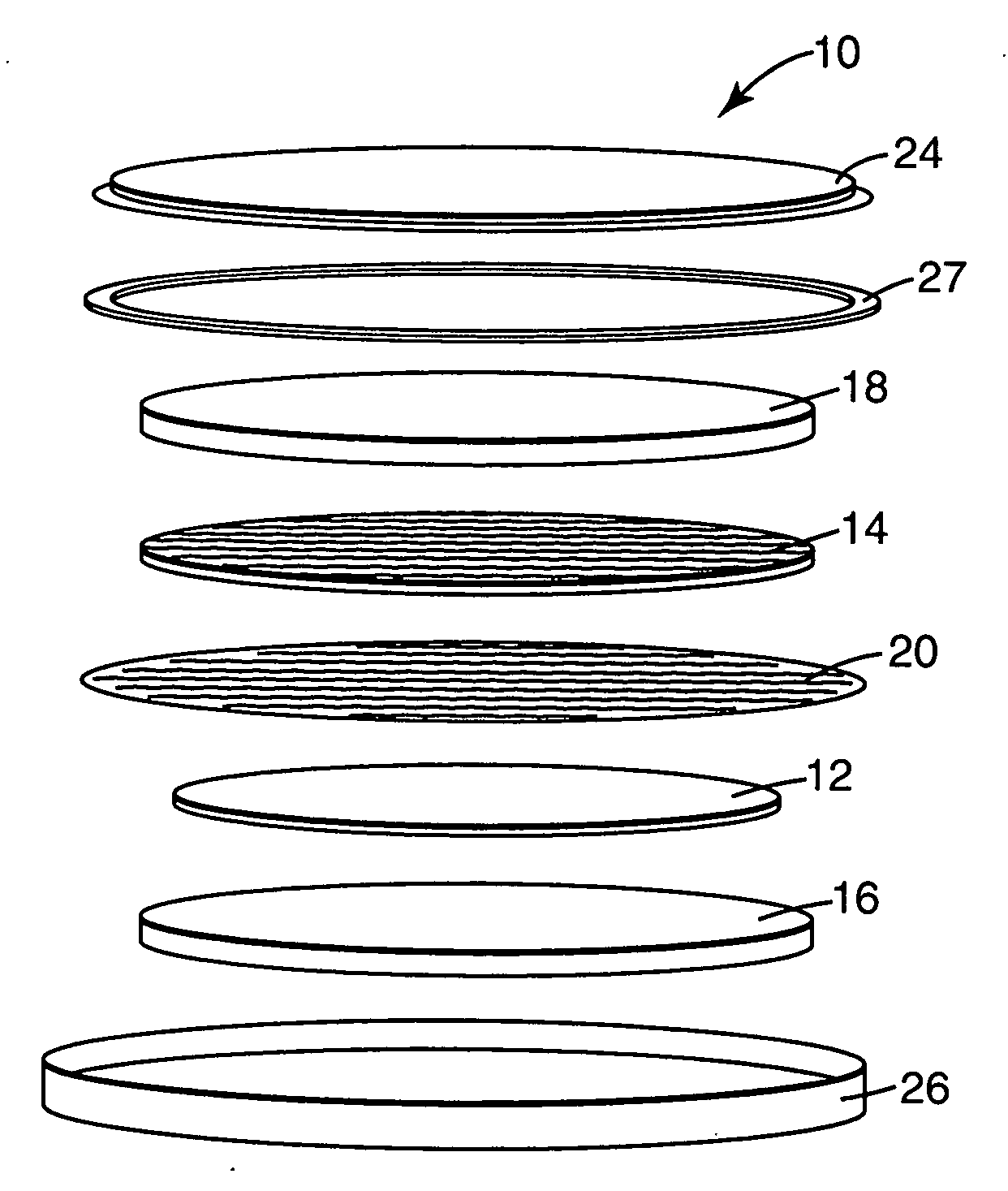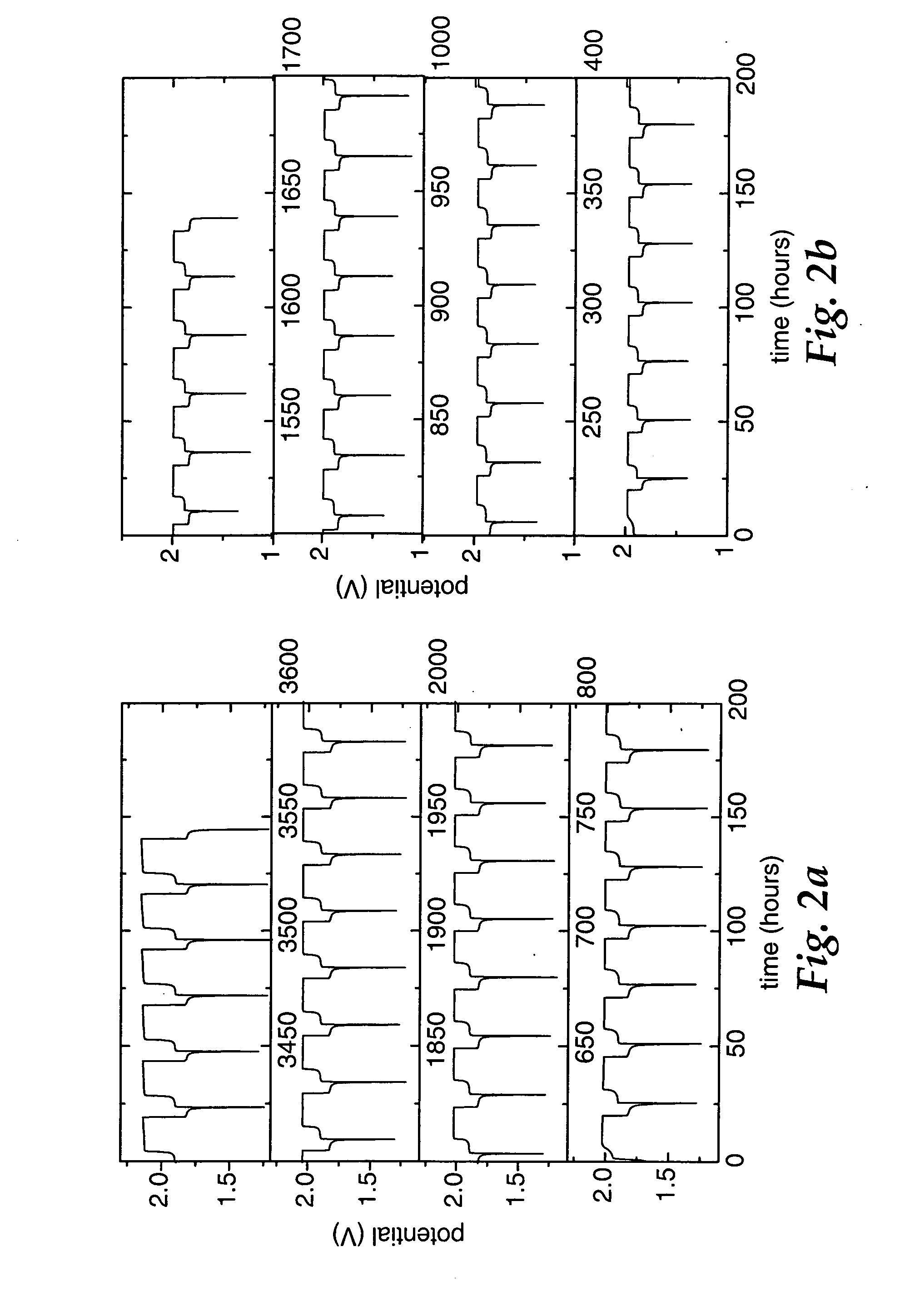Substituted phenothiazine redox shuttles for rechargeable lithium-ion cell
a lithium-ion cell and phenothiazine technology, applied in secondary cell servicing/maintenance, non-aqueous electrolyte cells, cell components, etc., can solve problems such as circuitry adding cost and complexity, affecting the quality of the circuit, and reducing the tolerance of large cells to electrical and mechanical abuse for consumer applications
- Summary
- Abstract
- Description
- Claims
- Application Information
AI Technical Summary
Problems solved by technology
Method used
Image
Examples
example 1
[0051] Negative electrodes were made from Li4 / 3Ti5 / 3O4 (synthesized according to the procedure shown in K. M. Colbow, R. R. Haering and J. R. Dahn, “Structure and Electrochemistry of the Spinel Oxides LiTi2O4 and Li4 / 3Ti5 / 3O4”, J. Power Sources, 26, 397-402 (1989)) using the following procedure. 100 Parts of the negative electrode active material (viz., Li4 / 3Ti5 / 3O4), 5 parts KYNAR™ 301P polyvinylidene fluoride (commercially available from Atofina Chemicals, Philadelphia, Pa.) and 5 parts SUPER S™ Carbon Black (commercially available from MMM Carbon, Tertre, Belgium) were mixed with N-methylpyrrolidinone to form a slurry. After thorough mixing in a polyethylene bottle containing spheres of ZIRCOA™ 6.35 mm diameter zirconium oxide banded satellite spherical media (commercially available from Zircoa, Inc., Solon, Ohio), the slurry was coated in a thin film on an aluminum foil current collector. The resulting coated electrode foil was dried in air overnight at 90° C. Individual 1.3 cm ...
example 2
[0057] Using the method of Example 1, the assembled cells were cycled at 55° C. using C / 10, C / 5, C / 2, “C 1.5” (1.5 hour charge and 1.5 hour discharge) or C rates. The shuttle test cell cycling results are shown below in Table 2:
TABLE 2Coin Cell Cycling Performance at 55° C. Using 0.1 M MPT,LiFePO4 Positive Electrodes and Li4 / 3Ti5 / 3O4 Negative ElectrodesOverchargeCharge / (OC) / Over-RunDrawingLithiumSepara-DischargedischargeNo.FigureSalttorsRate(OD)Cycles2-17aLiBOB2C / 10OC692-27bLiPF62C / 10OC322-38aLiBOB2C / 10OC / OD33 OD35 OC2-48bLiPF62C / 10OC / OD262-59aLiBOB2C / 5OC972-69bLiPF62C / 5OC312-710 LiBOB2C / 5OC / OD21 OC30 OD2-811 LiBOB2COC352-912 LiBOB2COC / OD13 OD21 OC 2-1013 LiBOB21.5 COC / OD22 OD48 OC 2-11—LiPF61C / 2OC 44+ 2-12—LiPF61C / 2OC / OD26 OD19 OC 2-13—LiPF61COC / OD13 OD 2 OD
[0058] The results in Table 2 show that MPT provided overcharge and overdischarge protection in rechargeable lithium-ion cells at an elevated temperature and a variety of charge and discharge rates.
example 3
[0059] Using the general method of Example 1, coin-type test cells were prepared using 100 parts of mesocarbon microbeads (“MCMB”, a graphitic carbon with 3.45>d002>3.354 Å, obtained from E-One / Moli Energy Canada, Maple Ridge, B.C., Canada) in the negative electrode slurry in place of the Li4 / 3Ti5 / 3O4 negative electrode material employed in Example 1. The MCMB slurry was coated onto a copper foil current collector to prepare negative electrodes having a specific capacity of about 300 mAh / g. Thus a 300 mA / g specific current could discharge a fully charged cell containing such electrodes in one hour. Cells made using these MCMB negative electrodes and 140 mAh / g LiFePO4 positive electrodes were charged and discharged using C-rates based on the positive electrode capacity. Because the MCMB negative electrode had more than twice the capacity of the LiFePO4 positive electrode, C-rates referenced to the negative electrode capacity would be less than one-half as large as those referenced to...
PUM
| Property | Measurement | Unit |
|---|---|---|
| Fraction | aaaaa | aaaaa |
| Electric potential / voltage | aaaaa | aaaaa |
| Electric potential / voltage | aaaaa | aaaaa |
Abstract
Description
Claims
Application Information
 Login to View More
Login to View More - R&D
- Intellectual Property
- Life Sciences
- Materials
- Tech Scout
- Unparalleled Data Quality
- Higher Quality Content
- 60% Fewer Hallucinations
Browse by: Latest US Patents, China's latest patents, Technical Efficacy Thesaurus, Application Domain, Technology Topic, Popular Technical Reports.
© 2025 PatSnap. All rights reserved.Legal|Privacy policy|Modern Slavery Act Transparency Statement|Sitemap|About US| Contact US: help@patsnap.com



